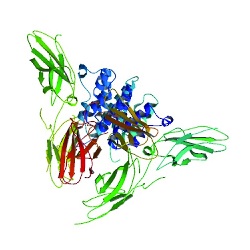Interferons (IFNs) are low molecular weight proteins that belong to the class of glycoproteins known as cytokines. IFNs are part of the non-specific immune system and are an important first line of defense against viral infections. They are released by host cells in response to the presence of pathogens such as viruses, bacteria, parasites or tumor cells.
IFNs have other functions as well: they activate immune cells, such as natural killer cells and macrophages; they increase recognition of infection or tumor cells by up-regulating antigen presentation to T lymphocytes; and they increase the ability of uninfected host cells to resist new infection by virus. Host symptoms, such as aching muscles and fever, are related to the production of IFNs during infection.
Interferons are also important in drug therapy for many diseases involving the immune system with extensive research being carried out on their use to treat diseases such as Multiple Sclerosis (MS) and Hepatitis. The mechanism of action by which interferons work is complex and advances in medicine and our understanding of the role of interferons will make a substantial impact on how diseases will be treated in the future.
Classification of IFNs
IFNs are classified as Type I, II or III based on receptor complex recognition and protein structure.

Mammalian type I IFNs consist of over nine distinct classes that include IFN-α, IFN-β, IFN-δ, IFN-ε, IFN-κ, IFN-ω, IFN-υ, IFN-τ and IFN-ζ. While IFN-α, IFN-β, IFN-ε, IFN-κ, IFN-ω, and IFN-υ are found in humans, IFN-δ, IFN-τ and IFN-ζ are not. These IFNs bind to the type I receptor which is composed of two chains, commonly designated IFNAR1 and IFNAR2. Type I IFNs are typically produced by macrophages, neutrophils, dendritic cells and other somatic cells in response to many viruses and some pathogens.
Type II IFN in humans is limited to a single IFN-γ gene. This IFN binds to the Type II receptor comprised of IFNGR1 (IFN-γR1) and IFNGR2 (IFN-γR2) chains. IFN-γ is produced by cells of the immune system such as T-cells and NK cells. IFN-γ is glycosylated in mammalian cells, and functions as a homodimer. On a mass basis, IFN-α and IFN-β exhibit more potent antiviral activity than IFN-γ.
Type III IFNs [IFN-λ1 (IL-29), IFN-λ2 (IL-28A), and IFN-λ3 (IL-28B)] are newly identified class II cytokine receptor ligands that are distantly related to members of the IL-10 family (11-13% amino acid sequence identity) and type I IFN family (15-19% amino acid sequence identity).
PBL Assay Sciences – leading manufacurer of Interferons

Founded by Dr. Sidney Pestka who is known as the “Father of Interferon” for his seminal work on interferon that gave birth to what is, today, a $6 billion dollar market directed at the therapy of hepatitis, multiple sclerosis, cancer, and other diseases, PBL Assay Sciences offers a comprehensive range of interferons from different species and of different classes including multiple IFN-alpha and IFN-beta subtypes.
To get a complete overview of these highly active interferons, take a look at the list of available IFNs.
Most recently, a set of human cell derived IFN lambda proteins has been made available. As a example the activity of of human IFN lambda 2 measured in an A549/EMCV Cytopathic Effect Protection assay is shown in Fig. 2.
Furthermore, a wide variety of high quality ELISA kits to detect interferons and anti interferon antibodies is available (through tebu-bio in Europe).
If you are interested in Interferon related products and would like to receive more information, just use the form below!



